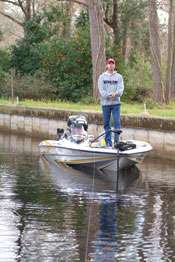
There are few things in bass fishing more enjoyable than cranking shallow, visible cover.
No technique is more hands-on and involves the angler more on both a visual and sensitivity level. These senses are utilized from the beginning of each cast until the end of the retrieve. A strike can occur any second in between.
That is shallow cranking. No struggling to detect a long-distance bite at the end of a Carolina rig. No trying to decipher the difference between a strand of grass and the subtle bite of a heavy-cover bass while flipping. No blindly probing deep water structure with a jigging spoon."Shallow cranking is chunkin' and windin'," Jeff Coble says. "It's about the most fun you can have with a rod and reel."
Coble should know. Born and raised in the crankbait country known as North Carolina, his tournament credentials include two appearances in the Bassmaster Classic, winning the inaugural ESPN Outdoors Bassmaster Series Championship and more than $500,000 in career earnings —most directly attributable to his skills with shallow diving plugs."Shallow cranking to me is zero to 6 feet," he notes. "In my part of the country it comes into play most in the spring and in the fall. In the hotter months you usually have to go to deeper diving crankbaits.
"In the springtime, you can score your best catches of the year on shallow cranks. The fish are heading shallow in big numbers to get ready to spawn and they are feeding. You can catch them shallow in the fall, but they'll be scattered out more following baitfish. The springtime is when you're going to catch the biggest stringers of the year on shallow-running crankbaits."Because Coble is not sponsored by any particular crankbait manufacturer —and he has experimented with them as much as any angler this side of fellow Carolinian David Fritts — he incorporates a variety of wooden and plastic cranks, and is refreshingly candid about the subject.
Coble is a big fan of WEC Crankbaits, named from the initials of Zoom Bait Co. founder Ed Chambers Sr. The handcrafted, hand-painted cranks are made of balsa and top-quality hardware. The WEC flat-sided Tapp earned Coble $100,000 in his 2000 Red Man All-American victory on Arkansas' Lake Hamilton.
"Ed makes fine baits," Coble says. "I think his crankbaits are a cut above. His are just more consistent."He spent a lot of time developing and learning how to make crankbaits. He's bought a lot of little crankbait companies that went out of business. He bought their tools and learned how to build them."Although casting to visible objects may be the great equalizer among fishermen of all skill levels, Coble emphasizes that shallow cranking involves more than that.
"Shallow cranking isn't always throwing to targets you can see, although that's the most fun," Coble continues.
"I like to find the little stuff that's not visible to the naked eye, like shallow stumps in 4 to 6 feet of water or rockpiles and brushpiles. We don't have a lot of grass in our part of the country, but I do catch them in other areas of the country with shallow running crankbaits in and around (submerged) weeds."
It might surprise some BASS fans to learn that this cranking expert begins fishing the shallow divers when the water temperature approaches 50 degrees in the early spring. That is the time when he ties on a No. 5 or No. 7 Shad Rap ("There is no equal to a Shad Rap when it comes to catching fish in the springtime."). As the water warms, he begins fishing a Luhr Jensen Speed Trap and a WEC Z1 model. His other springtime choices include small Bandit and Norman cranks.The WEC Z1, a small wooden bait with a short, square lip that runs about 4 feet deep, is productive throughout the spring.His most productive colors for shallow fall cranking are shad patterns, as well as variations of chartreuse.
"In the spring, if we've had a cold front, I fish inside turns or points around steep drops," Coble adds. "As the water temperature warms up they'll move up on shallow flats. At that time you really don't have to concentrate on cover; you can catch fish just going down the bank.
"In the fall, I start catching fish in the backs of creeks on shallow crankbaits like Bagley Kill'r B type baits. I'll throw Speed Traps when I need something a little deeper. I fish the backs of creeks and shallower flats because usually the main lake is not very good that time of the year for shallow crankbaits. That time of the year you need to get around cover like stumps, rocks and brush. In the spring, it's not that critical that you hit cover, but in the fall you have to be making contact."
TOOLS OF THE TRADE
All of Jeff Coble's shallow crankbaiting is done with a medium action 7-foot custom graphite rod by local rod maker Bill Poe (from an 843 G.Loomis blank). Most involves 10-pound-test clear Stren monofilament spooled on a Quantum E600 PT baitcast reel (4.4-to-1 gear ratio).After years of refining the technique, Coble sticks with baitcast gear even when fishing the lightweight Shad Raps.
"The No. 5 is very difficult to throw on casting equipment, but I still do it," he explains. "On those small crankbaits I'll sometimes wrap a little lead wire around the shank of the hooks. That makes them throw a little better. But you have to be careful that you don't use so much that it sinks."
